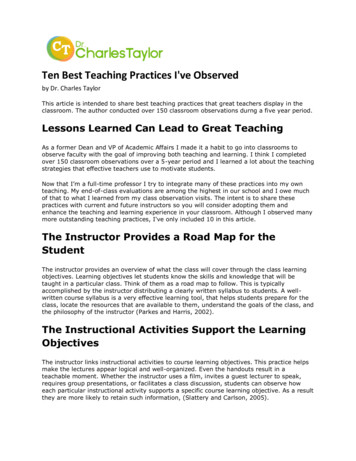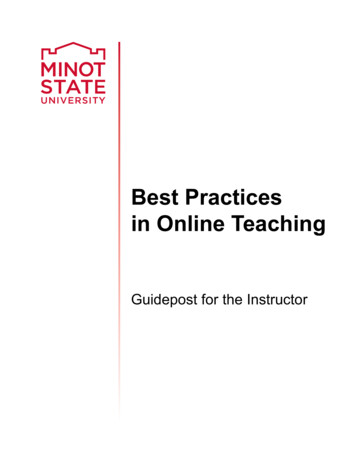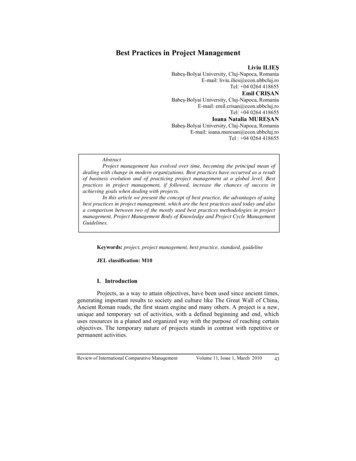
Transcription
Ten Best Teaching Practices I've Observedby Dr. Charles TaylorThis article is intended to share best teaching practices that great teachers display in theclassroom. The author conducted over 150 classroom observations durng a five year period.Lessons Learned Can Lead to Great TeachingAs a former Dean and VP of Academic Affairs I made it a habit to go into classrooms toobserve faculty with the goal of improving both teaching and learning. I think I completedover 150 classroom observations over a 5-year period and I learned a lot about the teachingstrategies that effective teachers use to motivate students.Now that I’m a full-time professor I try to integrate many of these practices into my ownteaching. My end-of-class evaluations are among the highest in our school and I owe muchof that to what I learned from my class observation visits. The intent is to share thesepractices with current and future instructors so you will consider adopting them andenhance the teaching and learning experience in your classroom. Although I observed manymore outstanding teaching practices, I've only included 10 in this article.The Instructor Provides a Road Map for theStudentThe instructor provides an overview of what the class will cover through the class learningobjectives. Learning objectives let students know the skills and knowledge that will betaught in a particular class. Think of them as a road map to follow. This is typicallyaccomplished by the instructor distributing a clearly written syllabus to students. A wellwritten course syllabus is a very effective learning tool, that helps students prepare for theclass, locate the resources that are available to them, understand the goals of the class, andthe philosophy of the instructor (Parkes and Harris, 2002).The Instructional Activities Support the LearningObjectivesThe instructor links instructional activities to course learning objectives. This practice helpsmake the lectures appear logical and well-organized. Even the handouts result in ateachable moment. Whether the instructor uses a film, invites a guest lecturer to speak,requires group presentations, or facilitates a class discussion, students can observe howeach particular instructional activity supports a specific course learning objective. As a resultthey are more likely to retain such information, (Slattery and Carlson, 2005).
Ten Best Teaching Practices I've Observedby Dr. Charles TaylorThe Instructor Uses the Entire Classroom SpaceThe instructor circulates in the classroom to check all students' performances. This preventsstudents from internet surfing or talking in the back of the room. It helps keep studentsengaged and when combined with discussion questions, it helps to create an interactivelearning environment as opposed to a passive one.There is nothing that motivates students more than knowing that the instructor is activelyparticipating in the lesson. Lack of interest or enthusiasm on part of the instructor can easilylead to lack of interest on the part of the students. Furthermore, by moving around,instructors make themselves more approachable, and less intimidating as they occupy thesame physical spaces as their students, rather than always maintaining a distance bystanding at the podium or the front of the class.The Instructor Makes The Material RelevantThe instructor provides relevant examples, including real-world experiences anddemonstrations to illustrate concepts and skills. S/he intentionally makes a connectionbetween the content and the student's life. Critical pedagoge and noted scholar GloriaLadson-Billings (1995), while analyzing classroom practices of successful teachers, notesthat successful teachers utilize students' own cultural practices as a learning tool. Oneteacher used rap music to teach poetry and helped students understand literal andfigurative meanings with the kind of music they were interested in. Great teachers alwaysfind a way to make the material relevant.The Instructor Helps Students Develop SuperiorLearning SkillsThe instructor uses instructional strategies that encourage the development of criticalthinking, problem solving, and performance skills. The teacher asks questions that requirestudents to synthesize, analyze, and evaluate information. Great teachers question studentsabout their ideas, and the reason why they think a certain way in order to make themevaluate their own beliefs and the extent to which their ideas are a product of thoroughresearch about something or unfounded beliefs passed on by family and friends. Hynd(1999) suggests using multiple instead of single texts, to teach history for instance, in orderto allow space for multiple narratives.
Ten Best Teaching Practices I've Observedby Dr. Charles TaylorStudents Learn to be Responsible for Their OwnLearningThe instructor encourages students to be engaged in and responsible for their own learning.S/he challenges and motivates students to achieve at higher levels. The teachercommunicates to all students their progress so they know where they stand grade-wise atany moment in the semester. When there is a guest speaker the instructor requiresstudents to develop questions in advance. S/he has students go to the white board todemonstrate their knowledge in math and accounting classes.Students who are actively engaged in the material they are studying tend to learn more.One way of promoting interest and to get timely feedback from students is to encouragethem to keep a journal about the class (Park, 2003). Such a tool can provide usefulfeedback for the instructor and help the student to improve and understand their ownlearning issues pertaining to the subject matter.The Teacher Re-Teaches When NecessaryThe instructor sums up the learning objectives and answers any lingering questionsstudents may have. The teacher re-teaches when necessary. The instructor makeshim/herself approachable so that the students can get the most out of the classroomexperience. There are subtle cues by which students can get more comfortable in theclassroom, such as receiving encouragement upon asking a question, not being chastisedfor a question that is too 'simplistic', being encouraged to inquire when they don'tunderstand and the willingness of the teacher to repeat themselves often and upon requestfrom the student.The Instructor Gives Every Student a Chance toExcelThe instructor treats all students in a fair and equitable manner. S/he tries to involve thewhole class; doesn't just call on any particular group of students based on gender, race orethnicity, and offers both shy and extroverted students opportunities to excel in theclassroom. Maintaining an equitable, fluid and fair teaching relationship with all students is akey practice to discourage any unneccessary competition in the classroom (Ladson-Billings,1995). This sometimes involves switching the teacher-student role.A diverse classroom means different ways of learning, and in order to encourage everyoneto be engaged in the classroom, great teachers are flexible in accepting different modes of
Ten Best Teaching Practices I've Observedby Dr. Charles Taylorparticipation. Not every student will be a good public speaker, but that doesn't mean thatthey might not have good ideas to share. For those who might be too shy to speak up inclass, there can be alternative ways to express their opinions and still be part of the classdiscussion, such as through an online discussion forum.Instructor Provides Timely Feedback to Help theStudent Grow AcademicallyThe instructor provides supporting feedback after an incorrect response by probing,repeating the question, giving a clue, or allowing more time. S/he asks higher orderthinking questions and allows appropriate wait time after the question is posed. Greatteachers set aside time for students who are still struggling with a concept to get theassistance they need to understand it. This pracitce allows the instructor to collect studentfeedback on a regualr basis to determine what was learned and what might have beenconfusing.Students need to be challenged academically and they should be expected to meet highstandards, because unless the teacher expects a high quality of work from them, they maynot produce a high quality of work. Part of that process requires the teacher to provideexcellent feedback, and give very specific comments so that students can improve theirwork.The Instructor Keeps Students Engaged andInterestedThe instructor uses observable techniques to gain and maitain student interest andattention. The best technique I observed was instructors simply displaying plain-oldenthusiasm for teaching. That's contagious and it keeps students interested. Othertechniques worth noting include demonstrating good rapport, using students' names,maintaining good eye contact, and maintaining a good voice volume. These are things thatany instructor can emulate.Research suggests that student interest has a positive relationship with learning. Whenstudents are interested in the material they tend to understand it better. Shcraw et al.(2001) stresses the importance of well-organized texts to peak students interest. Gettingfeedback from students and incorporating their ideas into the material is another way greatteachers promote and maintain student interest in the course material.
Ten Best Teaching Practices I've Observedby Dr. Charles TaylorConclusionGood teaching practices help produce students who excel academically as well as who canengage critically with the world around them, and who are not merely able to reproducewhat their text books tell them, but to develop a critical sociopolitical understanding of theirworld. The above practices are aimed at providing a framework for achieving the most outof a classroom experience and for creating a safe environment that promotes opportunitiesfor mututal understanding and learning across students of diverse backgrounds. I hope youfound them helpfulReferencesHynd, C. R. (1999). Teaching students to think critically using multiple texts in history.Journal of Adolescent and Adult Literacy, 42(6), 428-436.Ladson-Billings, G. (1995). But that's just good teaching! The case for culturally relevantpedagogy. Theory into Practice, 34(3), 159-165. Retrieved ark, C. (2003). Engaging students in the learning process: the learning journal. Journal ofGeography in Higher Education, 27(2), 183-199. Retrieved fromhttp://www.lancs.ac.uk/people/gyaccp/cjgh 27 2 05lores.pdfParks, J., & Harris, M. B. (2002). The purposes of a syllbus. College Teaching, 50(2), 55-61.Retrieved from http://jan.ucc.nau.edu/ coesyl-p/syllabus cline article 2.pdfSchraw, G., Flowerday, T., & Lehman, S. (2001). Increasing situational interest in theclassroom. Educational Psychology Review, 13(3), 211-224. Retrieved fromhttps://www.msu.edu/ erest.pdfSlattery, J. M., & Carlson, J. F. (2005). Preparing an effective syllabus: current bestpractices. College Teaching, 53(4), 159-164. Retrieved opment/Slattery 2005.pdf 2011 Charles Taylor All rights reserved
Ten Best Teaching Practices I've Observed by Dr. Charles Taylor The Instructor Uses the Entire Classroom Space The instructor circulates in the classroom to check all students' performances.










